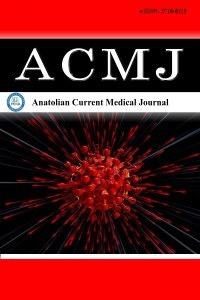Comparison of continuous thoracic epidural block and continuous thoracic paravertebral block for management of post thoracotomy pain: a randomised trial
Comparison of continuous thoracic epidural block and continuous thoracic paravertebral block for management of post thoracotomy pain: a randomised trial
___
- Mesbah A, Yeung J, Gao F. Pain after thoracotomy. BJA Education 2016; 16: 1-7.
- Komatsu T, Sowa T, Takahashi K, Fujinaga T. Paravertebral block as a promising analgesic modality for managing post-thoracotomy pain. Ann Thorac Cardiovasc Surg 2014; 20: 113-6.
- Júnior Ade P, Erdmann TR, Santos TV, et al. Comparison between continuous thoracic epidural and paravertebral blocks for postoperative analgesia in patients undergoing thoracotomy: Systematic review. Braz J Anesthesiol 2013; 63: 433-42.
- Romero A, Garcia JE, Joshi GP. The state of the art in preventing postthoracotomy pain. Semin Thorac Cardiovasc Surg 2013; 25: 116-24.
- Thompson C, French DG, Costache I. Pain management within an enhanced recovery program after thoracic surgery. J Thorac Dis 2018; 10: 3773-80.
- Gerner P. Postthoracotomy pain management problems. Anesthesiol Clin 2008; 26: 355-67, vii.
- Yokoyama Y, Nakagomi T, Shikata D, Goto T. Combined analgesic treatment of epidural and paravertebral block after thoracic surgery. J Thorac Dis 2017; 9: 1651-7.
- Chin JWE, Valchanov K. Pharmacological management of post-thoracotomy pain. Open Med J 2016; 3: 255-64.
- Mathews TJ, Churchhouse AM, Housden T, Dunning J. Does adding ketamine to morphine patient-controlled analgesia safely improve post-thoracotomy pain? Interact Cardiovasc Thorac Surg 2012; 14: 194-9.
- Richardson J, Sabanathan S, Jones J, Shah RD, Cheema S, Mearns AJ. A prospective, randomized comparison of preoperative and continuous balanced epidural or paravertebral bupivacaine on post-thoracotomy pain, pulmonary function and stress responses. Br J Anaesth 1999; 83: 387-92.
- Chou R, Gordon DB, de Leon-Casasola OA, et al. Management of Postoperative Pain: A Clinical Practice Guideline From the American Pain Society, the American Society of Regional Anesthesia and Pain Medicine, and the American Society of Anesthesiologists’ Committee on Regional Anesthesia, Executive Committee, and Administrative Council. J Pain 2016; 17: 131-57.
- Yeung JH, Gates S, Naidu BV, Wilson MJ, Gao Smith F. Paravertebral block versus thoracic epidural for patients undergoing thoracotomy. Cochrane Database Syst Rev 2016; 2: CD009121.
- Davies RG, Myles PS, Graham JM. A comparison of the analgesic efficacy and side-effects of paravertebral vs epidural blockade for thoracotomy--a systematic review and meta-analysis of randomized trials. Br J Anaesth 2006; 96: 418-26.
- Richardson J, Cheema S. Thoracic paravertebral nerve block. Br J Anaesth 2006; 96: 537.
- Alzahrani T. Pain relief following thoracic surgical procedures: A literature review of the uncommon techniques. Saudi J Anaesth 2017; 11: 327-31.
- Messina M, Boroli F, Landoni G, et al S. A comparison of epidural vs. paravertebral blockade in thoracic surgery. Minerva Anestesiol 2009; 75: 616-21.
- Gulbahar G, Kocer B, Muratli SN, et al. A comparison of epidural and paravertebral catheterisation techniques in post-thoracotomy pain management. Eur J Cardiothorac Surg 2010; 37: 467-72.
- Karmakar MK. Thoracic paravertebral block. Anesthesiology 2001; 95: 771-80.
- Lönnqvist PA, MacKenzie J, Soni AK, Conacher ID. Paravertebral blockade. Failure rate and complications. Anaesthesia 1995; 50: 813-5.
- Cuschieri RJ, Morran CG, Howie JC, McArdle CS. Postoperative pain and pulmonary complications: comparison of three analgesic regimens. Br J Surg 1985; 72: 495-8.
- Wu CL, Cohen SR, Richman JM, et al. Efficacy of postoperative patient-controlled and continuous infusion epidural analgesia versus intravenous patient-controlled analgesia with opioids: a meta-analysis. Anesthesiology 2005; 103: 1079-88; quiz 1109-10.
- Cousins MJ, Mather LE. Intrathecal and epidural administration of opioids. Anesthesiology 1984; 61: 276-310.
- Blichfeldt-Eckhardt MR, Andersen C, Ørding H, Licht PB, Toft P. Shoulder Pain After thoracic surgery: type and time course, a prospective cohort study. J Cardiothorac Vasc Anesth 2017; 31: 147-51.
- Burgess FW, Anderson DM, Colonna D, Sborov MJ, Cavanaugh DG. Ipsilateral shoulder pain following thoracic surgery. Anesthesiology 1993; 78: 365-8.
- MacDougall P. Postthoracotomy shoulder pain: diagnosis and management. Curr Opin Anaesthesiol 2008; 21: 12-5.
- Yayın Aralığı: 6
- Başlangıç: 2019
- Yayıncı: MediHealth Academy Yayıncılık
Semih BAŞKAN, Musa ZENGİN, Murat AKÇAY, Feryal KORKMAZ AKÇAY, Erman CEYHAN, Ali ALAGÖZ
Ali Doğan DURSUN, Samet UÇAK, Orhan YAVUZ, Mediha Nur Zafer YURT, Behiye Büşra TAŞBAŞI, Elif Esma ACAR, Veli Cengiz ÖZALP, Mert SUDAĞIDAN
Rubella, cytomegalovirus and toxoplasmosis seroprevalence in pregnants in Çorum Province
Assessment of failed spinal anesthesia for cesarean section during COVID-19 pandemic
Changing profile of infective endocarditis during 31-year time course in a tertiary care hospital
Ali Erkan DUMAN, Yesim CETİNKAYA SARDAN
Figen PEHLİVANOĞLU, Mehtap TUNÇ, Hilal SAZAK, Polat PEHLİVANOĞLU, Musa ZENGİN, Ali ALAGÖZ
Hamide Ayben KORKMAZ, Ahmet KARAOĞLU, İlkay CEYLAN
Ferhat ÇAY, Hasan Basri ÇETİNKAYA
COVID-19 and COVID-19 vaccines-related subacute thyroiditis: analysis of a case series
Gülçin TÜRKMEN SARIYILDIZ, Canan ÇİÇEK, Aykut İlker ARSLAN, Mehmet Emin DEMİR
Murat YILDIZ, Deniz ÇELİK, Figen AKOĞLAN, Yeşim Güllü COŞKUN, Hatice BALDEDE
